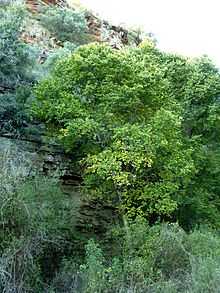Celtis africana
| Celtis africana | |
|---|---|
 | |
| C. africana growing in cliff shade | |
| Scientific classification | |
| Kingdom: | Plantae |
| (unranked): | Angiosperms |
| (unranked): | Eudicots |
| (unranked): | Rosids |
| Order: | Rosales |
| Family: | Cannabaceae |
| Genus: | Celtis |
| Species: | C. africana |
| Binomial name | |
| Celtis africana N.L.Burm. | |
Celtis africana (White Stinkwood) is a tree in the family Cannabaceae. The species is common across large areas of the South and East of Southern Africa, ranging from a tall forest tree to a medium-sized tree in bushveld and open country, to a shrub on rocky soil.
Description

Growing as an individual tree in the open under favourable conditions, Celtis africana is a tree of medium height, typically up to 12 m or so. It then usually forms a dense, hemispherical canopy. The bole of a mature tree then is thick and buttressed, often forked fairly near the ground. In forest it may grow up to 25 m tall, with a single, clean bole, though such large specimens usually are more or less buttressed too. In an exposed, rocky position it may be a bonsai-like small shrub. The trunk has a smooth, pale grey to white bark that may be loosely peeling in old trees and commonly has horizontal ridges.[1]
The tree is deciduous in the drier, frostier interior of its range in Africa, but semi-deciduous nearer the coast; in areas with wetter, milder winters it commonly retains its old leaves till after the spring leaf flush appears. In spring it produces light green, tender, new leaves that contrast with the pale bark. The leaves are simple, alternate, ovate to acuminate in shape with three distinct veins from the base. The leaf margin is slightly toothed (specifically serrate) towards the apex, whereas the basal third tends to be entire. The new leaves are bright, fresh green and hairy on the upper surface; they turn darker green and become smoother as they mature. (Leaf size: 15 to 100mm length x 10 to 50 mm breadth).[2]
Range and habitat
Occurs in a wide variety of habitats from wet forest and coastal bush to bushveld, mountain gorges and open country, typically savanna. Its range extends from the Western Cape, Eastwards and Northwards around the Southern African coastline, extending inland in the warmer, wetter regions,[3] and further North into Ethiopia[4]
Ecology
Celtis africana leaves are browsed by cattle and goats, and also eaten from the ground when shed.
Various species of Celtis are food plants for the larvae of various species of long-nosed butterfly; the genus Libythea. In particular, Celtis africana is the host to Libythea labdaca. The leaves also provide food for the larvae of Caloptilia celtina.

The inconspicuous, small, greenish, star-like flowers appear in early spring (August to October). Male and female flowers are separate, but they are produced on the same tree. Various insects pollinate them, particularly honeybees.
From October to February, following flowering, the rounded, berry-like fruit (botanically speaking drupes) appear. They are borne in large numbers on stalks about 1–2 cm long. As they ripen they change from green to yellow-brown or black. Though small, they typically are plentiful enough to be an important item of diet for many species of frugivorous birds that feed on the fruits and disperse the seeds in their manure. As a result, the seedlings not only may sprout far from the parent trees, but germinate unpredictably in all sorts of cracks in rocks or rotting wood as well as in fortunate locations in good soil. Their attraction for birds renders Celtis africana a popular tree in planning bird-friendly gardens.
Fruit and seeds are eaten by:[5]
- Amblyospiza albifrons (Thick-billed Weaver)
- Cercopithecus pygerythrus (Vervet monkey)
- Cinnyricinclus leucogaster (Plum-coloured Starling)
- Colius species (Mousebirds)
- Columba arquatrix (Rameron pigeon)
- Cossypha caffra (Cape Robin)
- Cossypha dichroa (Chorister Robin-chat)
- Gallirex porphyreolophus (Purple-crested Lourie)
- Lybius torquatus (Black-collared Barbet)
- Papio hamadryas (Chacma baboon)
- Poicephalus robustus (Cape Parrot)
- Pycnonotus capensis (Cape Bulbul)
- Pycnonotus tricolor (Black-eyed Bulbul)
- Tauraco corythaix (Knysna Lourie)
- Trachyphonus vaillantii (Crested Barbet)
- Turdus smithi (Karoo Thrush)
- Turtur tympanistria (Tambourine dove)
- Urocolius indicus (Red-faced Mousebird)
Cultivation
The species is easily propagated from seed, though for best results it is well to collect ripe fruit from the tree itself because seeds in dropped fruit commonly have been damaged by insects. It is best to separate the seed from the fruit tissue before planting, because the pulp inhibits germination until it has been removed by the digestive processes of birds. Celtis africana is a useful tree for planting along roadsides in urban areas of southern Africa.[1]
Seedlings are best planted out in good soil several metres away from paving and walls, but once established, they will do well even in fairly challenging conditions.
There is some reluctance to plant the tree in small gardens because it grows quite large, and some care is necessary because heavy branches growing at an unfavourable angle may split off and fall dangerously. This can however be forestalled and prevented by competent pruning and other arboricultural practices.
| Wikimedia Commons has media related to Celtis africana. |
References
- ↑ 1.0 1.1 http://www.plantzafrica.com/plantcd/celtisafrican.htm
- ↑ https://www.wildcard.co.za/blog.htm?action=view-post&id=1857
- ↑ van Wyk, Piet; van Wyk, Ben-Erik; van Wyk, Esterhuyse: "Photographic Guide to Trees of Southern Africa" Publisher: Briza ISBN 978-1-875093-24-3
- ↑ Palmer, Eve; Pitman, Norah (1972). Trees of Southern Africa. A. A. Balkema.
- ↑ http://www.biodiversityexplorer.org/plants/cannabaceae/celtis_africana.htm
Further reading
- Pooley, E. 1993. The Complete Field Guide to Trees of Natal, Zululand and Transkei. ISBN 0-620-17697-0.